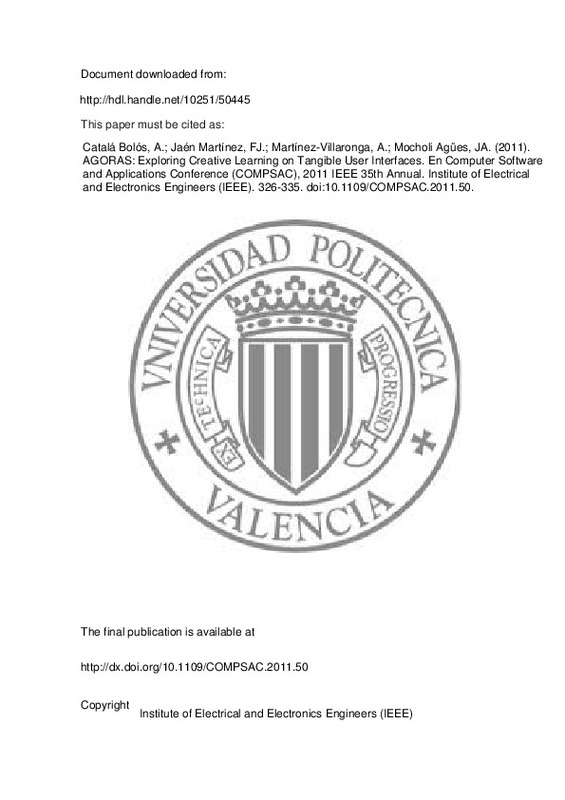JavaScript is disabled for your browser. Some features of this site may not work without it.
Buscar en RiuNet
Listar
Mi cuenta
Estadísticas
Ayuda RiuNet
Admin. UPV
AGORAS: Exploring Creative Learning on Tangible User Interfaces
Mostrar el registro sencillo del ítem
Ficheros en el ítem
| dc.contributor.author | Catalá Bolós, Alejandro
|
es_ES |
| dc.contributor.author | Jaén Martínez, Francisco Javier
|
es_ES |
| dc.contributor.author | Martínez-Villaronga, Adrià
|
es_ES |
| dc.contributor.author | Mocholí Agües, Jose Antonio
|
es_ES |
| dc.date.accessioned | 2015-05-19T09:44:35Z | |
| dc.date.available | 2015-05-19T09:44:35Z | |
| dc.date.issued | 2011-07-18 | |
| dc.identifier.isbn | 978-0-7695-4439-7 | |
| dc.identifier.isbn | 978-1-4577-0544-1 | |
| dc.identifier.issn | 0730-3157 | |
| dc.identifier.uri | http://hdl.handle.net/10251/50445 | |
| dc.description.abstract | Departing from creative learning foundations, this paper discusses on the suitability of interactive tables as a grounding technology to support creative learning for several reasons: support for social learning, because the subjects share a physical space as in traditional non-digital technologies; communication during the creative, experimental and reflexive process is direct and not computer-mediated; and subjects can carry out the task in parallel on the same surface. Considering reflection, discussion and creation processes in a loop, an experiment with teenagers has been conducted comparing a digital-based against a pure tangible tabletop in a task of creating entities consisting of blocks and joint elements. This preliminary study, designed to obtain initial insights about whether the grounding technology may become a promising tool to support creative learning, explores some aspects such as productivity, complexity of designs and concurrent comanipulation. The results showed that subjects were more productive in terms of the number of solutions obtained using the non computer-mediated approach. However using the digital tabletop approach subjects design, on average, more complex or elaborate solutions in terms of the number of involved bodies and joints. Finally, an important finding was that teams established more frequently concurrent cooperation schemes in the digital tabletop condition by sharing more effectively the creation space. | es_ES |
| dc.description.sponsorship | This work was funded by the Spanish Ministry of Education and Science and Innovation under the National Strategic Program of Scientific Research, Development and Technological Innovation (I+D+i) and project TSI2010-20488. Our thanks to the Alaquas city council and the clubhouse’s managers. Thanks also to the team Polimedia of the office “Área de Información y Comunicaciones” (ASIC) for the support in computer hardware. A. Catalá is supported by a FPU fellowship from the Ministry of Education and Science of Spain with reference AP2006-00181. | es_ES |
| dc.language | Inglés | es_ES |
| dc.publisher | Institute of Electrical and Electronics Engineers (IEEE) | es_ES |
| dc.relation.ispartof | Computer Software and Applications Conference (COMPSAC), 2011 IEEE 35th Annual | es_ES |
| dc.rights | Reserva de todos los derechos | es_ES |
| dc.subject | Interactive surface | es_ES |
| dc.subject | Tabletop Displays | es_ES |
| dc.subject | Tangible User Interface (TUI) | es_ES |
| dc.subject | Creativity | es_ES |
| dc.subject.classification | LENGUAJES Y SISTEMAS INFORMATICOS | es_ES |
| dc.title | AGORAS: Exploring Creative Learning on Tangible User Interfaces | es_ES |
| dc.type | Capítulo de libro | es_ES |
| dc.identifier.doi | 10.1109/COMPSAC.2011.50 | |
| dc.relation.projectID | info:eu-repo/grantAgreement/MICINN//TIN2010-20488/ES/CREATEWORLDS: UNA PLATAFORMA PARA EL APRENDIZAJE CREATIVO SOBRE MESAS INTERACTIVAS/ | es_ES |
| dc.relation.projectID | info:eu-repo/grantAgreement/MEC//AP2006-0018/ES/AP2006-0018/ | es_ES |
| dc.rights.accessRights | Abierto | es_ES |
| dc.contributor.affiliation | Universitat Politècnica de València. Departamento de Sistemas Informáticos y Computación - Departament de Sistemes Informàtics i Computació | es_ES |
| dc.description.bibliographicCitation | Catalá Bolós, A.; Jaén Martínez, FJ.; Martínez-Villaronga, A.; Mocholí Agües, JA. (2011). AGORAS: Exploring Creative Learning on Tangible User Interfaces. En Computer Software and Applications Conference (COMPSAC), 2011 IEEE 35th Annual. Institute of Electrical and Electronics Engineers (IEEE). 326-335. https://doi.org/10.1109/COMPSAC.2011.50 | es_ES |
| dc.description.accrualMethod | S | es_ES |
| dc.relation.publisherversion | http://dx.doi.org/10.1109/COMPSAC.2011.50 | es_ES |
| dc.description.upvformatpinicio | 326 | es_ES |
| dc.description.upvformatpfin | 335 | es_ES |
| dc.relation.senia | 205581 | |
| dc.contributor.funder | Ministerio de Ciencia e Innovación | es_ES |
| dc.contributor.funder | Ministerio de Educación y Ciencia | es_ES |







![[Cerrado]](/themes/UPV/images/candado.png)

